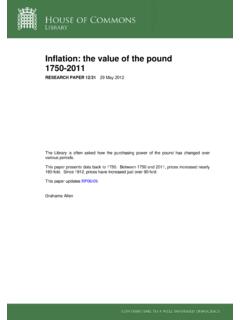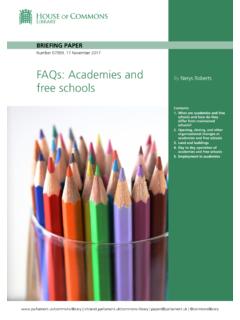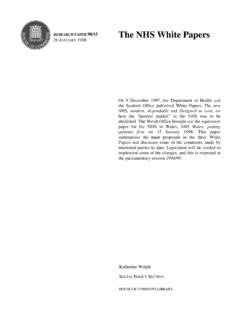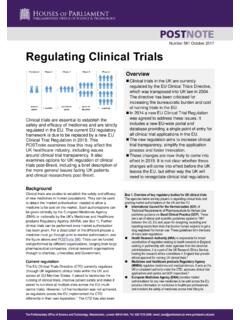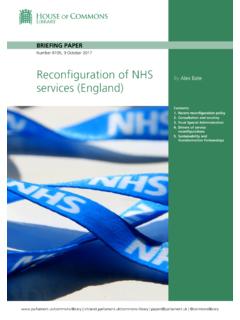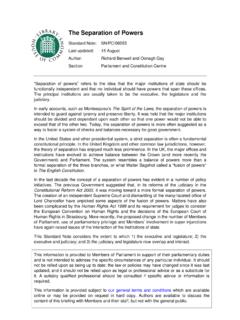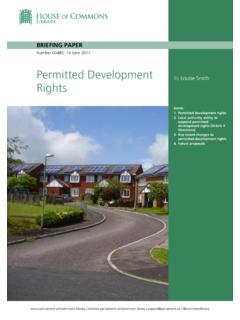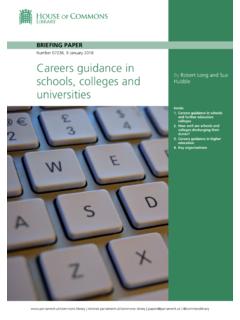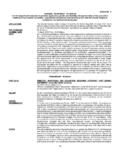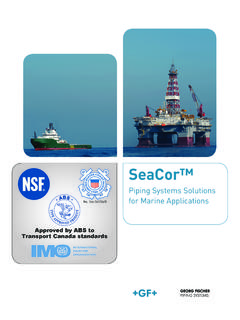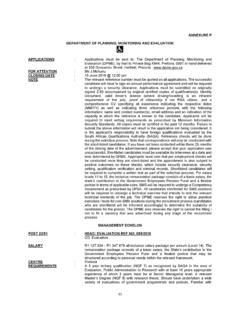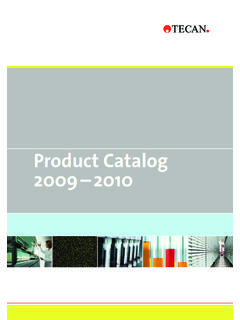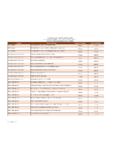Transcription of Railway rolling stock (trains)
1 | | | @commonslibrary BRIEFING PAPER Number CBP3146, 15 June 2017 Railway rolling stock (trains) By Louise Butcher Contents: 1. Overview of trains currently in use 2. Who owns the trains? 3. How are trains procured and leased? 4. Major rolling stock procurement programmes 5. Government policy, 1997- 2 Railway rolling stock (trains) Contents Summary 3 1. Overview of trains currently in use 4 2. Who owns the trains? 6 Privatisation 6 The big three ROSCOs 8 Angel Trains 8 Eversholt Rail 9 Porterbrook Leasing 9 3. How are trains procured and leased? 11 4. Major rolling stock procurement programmes 13 InterCity Express Programme (IEP) 13 Thameslink 16 Crossrail 1 (the Elizabeth Line ) 18 High Speed 2 (HS2) 19 5.
2 Government policy, 1997- 21 Labour Government, 1997-2010 21 Conservatives in Government since 2010 23 Industry views 24 Cover page image copyright Department for Transport & Hitachi via Flickr [cropped] 3 Commons Library Briefing, 15 June 2017 Summary This paper gives a brief overview of the GB train fleet, explains who owns the trains and how they are leased to the companies that provide train services. It also looks at four big rolling stock procurements: InterCity Express, Thameslink, Crossrail and HS2 and sets out the policies of successive governments. The bulk of the rolling stock (trains) that run on the railways are owned by three private companies ( rolling stock leasing companies, or ROSCOs) Angel, Eversholt and Porterbrook.
3 These companies lease the rolling stock to the train operating companies (TOCs) who then deploy it on their services. For the most part, the train companies procure the rolling stock directly from the rolling stock companies. In addition, in recent years the Government has stepped in to procure large rolling stock orders directly from the train manufacturers. Procurements for schemes such as the InterCity Express Programme, Thameslink and Crossrail have seen some controversy due to the award of successive contracts to companies based largely outside of the UK. Governments have been keen to get these companies to invest in UK skills and jobs.
4 There have been investigations into the rolling stock market over the past 10 years but no radical changes have been made by Government. The current Government s policy, dating back to 2010, is to design franchises that better incentivise rolling stock procurement and innovation. This is also a common theme for the industry, which wants to leverage emerging technology and alternative fuels to revolutionise train travel in the future. Information on other rail-related issues can be found on the Railways Briefings Page of the Parliament website. 4 Railway rolling stock (trains) 1. Overview of trains currently in use The average age of rolling stock on the GB rail network was years at Q4 2015/16.
5 This has been increasing year on year, though there are differences between franchised areas. For example, the oldest fleet on the network is the Caledonian Sleeper ( years) followed by MerseyRail ( years) TfL Rail ( years), and Great Western ( years). The newest fleet on the network is the TransPennine Express ( years), followed by Virgin West Coast ( years) and London Midland ( years).1 In March 2017 the rail industry published its fifth Long Term Passenger rolling stock Strategy. This gives an overview of the current train fleet and plans for future procurement. In summary, it said: Around half of the 6,000- plus new carriages costing 10 billion already committed for delivery from April 2014 to March 2021 have been or will be built in Britain.
6 These will replace 3,000 or more older vehicles, increasing the size and capacity of the national fleet by around 20%. The strategy estimates that: Britain s train fleet is forecast to grow by up to 89 per cent over 30 years; The average age of our trains is estimated to fall from 21 years to 15 years by March 2021; The proportion of electrically-powered vehicles is forecast to rise from 71 per cent now to more than 85 per cent by 2034; Between 11,000 and 16,000 new electric vehicles are expected to be needed by 2046, together with up to 2,000 new vehicles able to operate beyond the electrified The strategy also stated: The 6,010 new vehicles already delivered or now committed for delivery will increase the total active national fleet by 2,500 to 3,000 vehicles by 2024.
7 As a direct consequence of this, it can be concluded that some 3,000 to 3,500 existing vehicles will no longer be required by their present TOCs during this time, and will therefore come off lease (although some of these may find new uses during this period). The displaced vehicles will include: around 1,600 Type A, C, D and F vehicles, comprising many of the oldest passenger vehicles in the national fleet; around 1,400 Type E and Type F vehicles built in 1981 to 1995, mostly comprising middle distance EMUs, the majority being built by 1990; 1 ORR dataportal, Average age of rolling stock by franchised train operating company - Table [accessed 14 June 2017] 2 RDG press notice, Train fleet growth fastest for decades , 10 March 2017 5 Commons Library Briefing, 15 June 2017 around 300 Type B and Type E vehicles that were built after The present fleet composition (including committed changes to March 2017) is as follows:4 Generic Type Total Vehicles, March 2017 A.
8 Shorter Distance Self-Powered (diesel, generally with 75 mph maximum speed); 1,057 B. Middle Distance Self-Powered (diesel, with 90 or 100 mph capability); 1,367 C. Long Distance Self-Powered (diesel, with 100 or 125 mph capability); 1,500 D. Shorter Distance Electric (generally with 75 mph maximum speed); 2,461 E. Middle Distance Electric (with 90/ 100/ 110 mph capability); 5,670 F. Long Distance Electric (with 100/ 125/ 140 mph capability); 1,148 G. Very High Speed Electric (140 mph and above) 174 Total 13,377 Of these 13,377 vehicles, 6,778 (51%) have been built since privatisation, in the last 20 years; and 1,425 (11%) are owned by parties other than the three largest In 2015/16 the TOCs paid billion in rolling stock charges 12% of their total expenditure: the third highest single item after payments to the Government and staffing costs, and more than they pay in access charges to Network 3 RDG et al.
9 , Long Term Passenger rolling stock : Strategy for the Rail Industry (5th ed.), March 2017, para 21 4 ibid., table 2, page 15 5 ibid., para 57 6 ORR, UK Rail Industry Financial Information 2015-16, 22 February 2017, p16 6 Railway rolling stock (trains) 2. Who owns the trains? The trains in use of the GB rail network are not owned by the train companies who operate the service but by private companies called rolling stock leasing companies, or ROSCOs. These companies lease the rolling stock to the train operating companies (TOCs) who then deploy it on their services. For the most part, the train companies procure the rolling stock directly from the rolling stock companies.
10 In addition, in recent years successive Government have stepped in to procure large rolling stock orders directly from the train manufacturers, which are then owned by so-called mini-ROSCOs and again leased out to the TOCs. This structure is a direct result of the privatisation of the railways in the 1990s. Privatisation During the passage of what became the Railways Act 1993, the Conservative Government announced that private sector advisors would help to set up three passenger rolling stock companies as subsidiaries of British Rail (BR) from 1 April 1994. The companies would take over BR s existing domestic passenger rolling stock and lease it to future passenger service operators.

